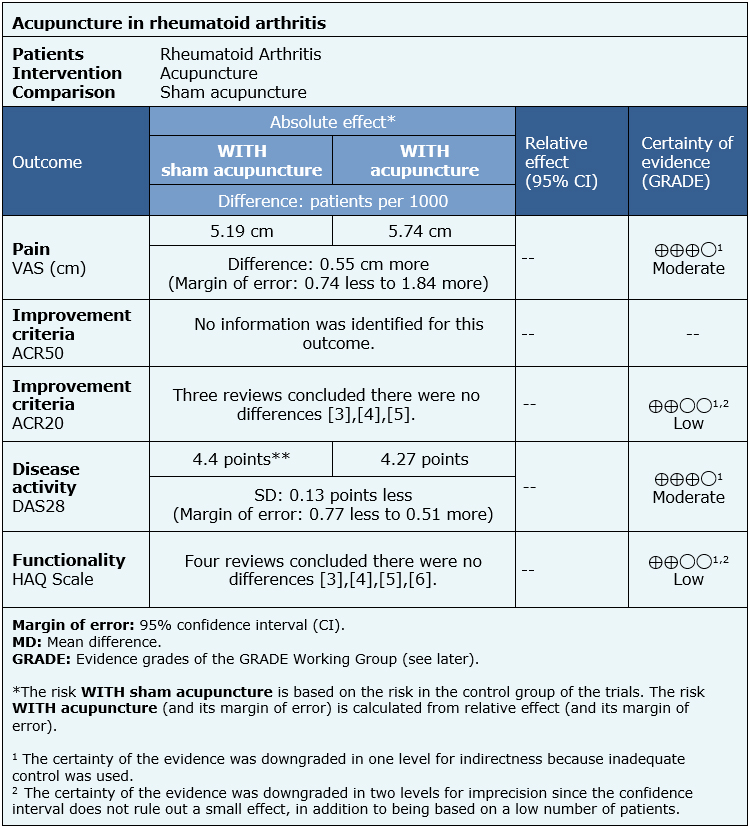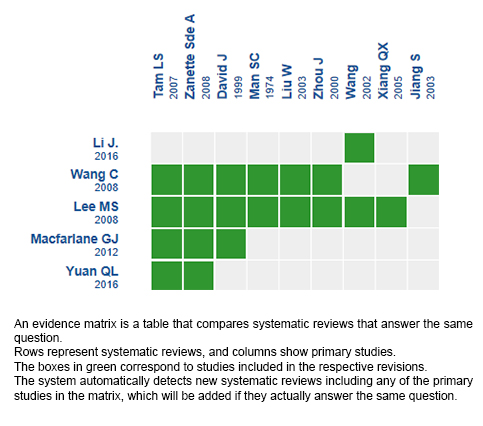Epistemonikos summaries
← vista completaPublished on October 10, 2018 | http://doi.org/10.5867/medwave.2018.06.7283
Acupuncture for rheumatoid arthritis
Acupuntura para el tratamiento de la artritis reumatoide
Abstract
INTRODUCTION Rheumatoid arthritis is the most common inflammatory arthritis worldwide. Chronic pain leads patients to use complementary therapies, including acupuncture.
METHODS To answer this question we used Epistemonikos, the largest database of systematic reviews in health, which is maintained by screening multiple information sources, including MEDLINE, EMBASE, Cochrane, among others. We extracted data from the systematic reviews, reanalyzed data of primary studies, conducted a meta-analysis and generated a summary of findings table using the GRADE approach.
RESULTS AND CONCLUSIONS We identified 7 systematic reviews including 20 studies overall, all of them randomized trials. We concluded the use of acupuncture probably has little or no impact in rheumatoid arthritis.
Problem
Rheumatoid arthritis is the most common autoimmune inflammatory arthritis in adults. Among the most frequent clinical manifestations are joint pain, swelling and stiffness. Whether due to toxicity, limited efficacy of current pharmacological alternatives, or other reasons, patients frequently seek complementary therapies in order to improve their symptoms, being acupuncture one of the most frequently used.
Acupuncture is a classic technique of traditional Chinese medicine, which involves the insertion of needles at specific points of the body with multiple therapeutic purposes, including local or generalized analgesia. For this reason, it is suggested that acupuncture could have a benefit in the symptomatic treatment of rheumatoid arthritis.
Methods
To answer the question, we used Epistemonikos, the largest database of systematic reviews in health, which is maintained by screening multiple information sources, including MEDLINE, EMBASE, Cochrane, among others, to identify systematic reviews and their included primary studies. We extracted data from the identified reviews and reanalyzed data from primary studies included in those reviews. With this information, we generated a structured summary denominated FRISBEE (Friendly Summary of Body of Evidence using Epistemonikos) using a pre-established format, which includes key messages, a summary of the body of evidence (presented as an evidence matrix in Epistemonikos), meta-analysis of the total of studies when it is possible, a summary of findings table following the GRADE approach and a section of other considerations for decision-making.
|
Key messages
|
About the body of evidence for this question
|
What is the evidence. |
We found seven systematic reviews [1],[2],[3], |
|
What types of patients were included* |
The patients included in these two trials [8],[9] were men and women over 18 years, with diagnosis of rheumatoid arthritis, independent of disease severity or time from diagnosis. |
|
What types of interventions were included* |
Both trials [8],[9] evaluated traditional Chinese acupuncture and analgesia intervention. One trial [8] performed twenty acupuncture sessions in ten weeks, with thirty-minute needle insertion in six acupuncture points: LI11, TE5, ST36, GB34, GB36, GB39.One trial [9] performed ten sessions of acupuncture in five weeks, with twenty-minute needle insertion in 16 acupuncture points: EX1, EX27, CV6, CV12, LI4, GV4, GV14, LR3, PC6, SP6, ST36, BL11, BL20, BL22, BL23, BL60.Both trials compared against penetrating sham acupuncture and analgesia. Sham acupuncture consists in inserting needles into puncture sites that are not specific to the studied condition, outside the acupuncture points (penetrating) or with a more superficial insertion compared to the acupuncture group (non-penetrating). The two trials used sham acupuncture of the penetrating type [8],[9]. |
|
What types of outcomes |
The trials evaluated multiple outcomes, which were grouped by the systematic reviews as follows:
|
* The information about primary studies is extracted from the systematic reviews identified, unless otherwise specified.
Summary of findings
The information about the effects of acupuncture in rheumatoid arthritis is based on two randomized trials that included 64 patients.
Both trials [8],[9] reported pain, disease activity, functionality and improvement using ACR20 criteria (64 patients). No trial evaluated improvement using ACR50 criteria and only one trial reported adverse effects [9].
No systematic review provided data on HAQ and ACR20 that could be re-analyzed, so the conclusions for these outcomes are presented as reported by the reviews.
The summary of findings is as follows:
- The use of acupuncture probably has minimal or no impact on joint pain in rheumatoid arthritis. The certainty of the evidence is moderate.
- No information on the effect of acupuncture on ACR50 was identified.
- The use of acupuncture might have minimal or no impact on ACR20, but the certainty of the evidence is low.
- The use of acupuncture probably has little or no impact on DAS28 score. The certainty of the evidence is moderate.
- The use of acupuncture might have minimal or no impact on the HAQ score, but the certainty of the evidence is low.

| Following the link to access the interactive version of this table (Interactive Summary of Findings – iSoF) |

Other considerations for decision-making
|
To whom this evidence does and does not apply |
|
| About the outcomes included in this summary |
|
| Balance between benefits and risks, and certainty of the evidence |
|
| Resource considerations |
|
| What would patients and their doctors think about this intervention |
|
|
Differences between this summary and other sources |
|
| Could this evidence change in the future? |
|
How we conducted this summary
Using automated and collaborative means, we compiled all the relevant evidence for the question of interest and we present it as a matrix of evidence.

Follow the link to access the interactive version: Acupuncture for rheumatoid arthritis.
Notes
The upper portion of the matrix of evidence will display a warning of “new evidence” if new systematic reviews are published after the publication of this summary. Even though the project considers the periodical update of these summaries, users are invited to comment in Medwave or to contact the authors through email if they find new evidence and the summary should be updated earlier.
After creating an account in Epistemonikos, users will be able to save the matrixes and to receive automated notifications any time new evidence potentially relevant for the question appears.
This article is part of the Epistemonikos Evidence Synthesis project. It is elaborated with a pre-established methodology, following rigorous methodological standards and internal peer review process. Each of these articles corresponds to a summary, denominated FRISBEE (Friendly Summary of Body of Evidence using Epistemonikos), whose main objective is to synthesize the body of evidence for a specific question, with a friendly format to clinical professionals. Its main resources are based on the evidence matrix of Epistemonikos and analysis of results using GRADE methodology. Further details of the methods for developing this FRISBEE are described here (http://dx.doi.org/10.5867/medwave.2014.06.5997)
Epistemonikos foundation is a non-for-profit organization aiming to bring information closer to health decision-makers with technology. Its main development is Epistemonikos database (www.epistemonikos.org).
Potential conflicts of interest
The authors do not have relevant interests to declare.

